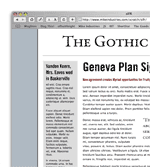sIFR 2.0 RC 3 is Here… Come Get Some
UPDATE: Version 2.0 is now available. See article here.
 Alright, I know I said Release Candidate 2 might be the final release of sIFR 2.0, but hey, Mark and I found some more things to improve on… so we did. Today’s release of sIFR 2.0 RC3 introduces the following new features/fixes/improvements:
Alright, I know I said Release Candidate 2 might be the final release of sIFR 2.0, but hey, Mark and I found some more things to improve on… so we did. Today’s release of sIFR 2.0 RC3 introduces the following new features/fixes/improvements:
- The javascript file has been reduced down to 8.8k.
- Replacement calls now use named arguments so you don’t need to specify parameters in any particular order. The function is backwards-compatible, however, so existing installs will remain functional.
- Newline support (
<br>and<br />) now works perfectly. - Now compatible with Opera 7 and above.
- New support for a “fallback” transparency color for browsers which don’t support transparency. This eliminates the green background displayed in some older browsers when specifying transparency.
- A shiny new sIFR logo!
Since all changes from RC2 to RC3 are contained within the “sifr.js” file, you need only replace your existing “sifr.js” file to complete the upgrade. No .html or .swf work is necessary. You may, however, decide to change your replacement calls to the new named argument syntax if you wish. This is not necessary, but you may find it preferable.
Note: if you are using a version earlier than RC2, please re-export your swfs as well.
Here are links to the new files and updated example page:
Incidentally, it looks like Metafilter has picked up on sIFR today and is sending over a ton of traffic to the original sIFR article. Thanks guys!
Reading the Metafilter comment thread is a bit humorous, however. It never ceases to amaze me how some people will see the word “Flash” and cry about imaginary accessibility issues, imaginary proprietary file format issues, and other imaginary “sky is falling” issues. Look at the code people. Study it. Analyze it. Understand it before you jump to conclusions. And above all else, understand that the entire web as we know it is a hack. I’d respond on the Metafilter thread myself but I don’t feel like paying $5 to join.
sIFR 2.0: Release Candidate 2 is Finally Here
UPDATE: Version 2.0 is now available. See article here.
Alright, sIFR Release Candidate 2 is finally here. It’s been exactly two months since Release Candidate 1 and we’re happy to say that things have held up very well so far. Release Candidate 2 fixes a handful of minor issues, and barring any regression behavior which may turn up in RC2 (but probably won’t), we think we have a solid 2.0 release on our hands. Thankfully, we’ve taken care of this before the end of 2004, because according to the 2005 Web Design Forecast, sIFR will be a huge part of the emerging typographical landscape in the coming year.
We couldn’t agree more.
Before I get into the details of RC2, I just want to thank Mark Wubben for a) all the great javascript work he’s done on sIFR, and b) all the helpful support he’s provided to people asking for assistance in the comments. There have been over 700 comments on all sIFR threads so far, and Mark has managed to successfully attend to almost all of them which pertain to javascript or implementation. So once again, thanks Mark for being so helpful, and also for being a genius.
I also want to thank Danilo Celic and Stephanie Sullivan of Community MX for their help in bringing sIFR to the masses. Check out Danilo’s Breeze Presentation for a great overview of sIFR and also a peek at the power of Macromedia Breeze. I love Breeze more every time I see it.
And finally, two more thank yous. One to Zen Master Dave Shea for his helpful, even-handed, positive review of sIFR, and one to Sean Schroeder for his beautiful sIFR work on Prosper Magazine.
Oh yeah, and I almost forgot, Wes Carr and the folks at 2Entwine have taken sIFR and expanded it into Fotobuzz.org, a photo annotation engine. Instead of replacing text with sIFR, Fotobuzz replaces images for the purpose of annotating them inside Flash. It is really really slick. Make sure and check it out.
Now… on to the details.
First of all, to upgrade to sIFR 2.0 RC2, you need only re-export your .swf files and pop in the new sifr.js file. No implementation details have changed. So in other words, upgrading should only take a minute.
Here’s what we’ve improved/changed/fixed:
- sIFR now works in all reasonable versions of Opera. This should include all flavors of 7.x on both platforms.
- URLs of unlimited length are now supported. Flash unfortunately has a 128-character URL limit on textfields, but we’ve gotten around that with some crafty coding.
- Newline support is now added. If you place
<br />'sin your replaced elements, they will now be honored. - HTTPS is now supported for domain-protected files.
- sIFR now uses exact domain matching for domain-protected files. As a result, two-part domains like .co.uk are now eligible for protection.
- Various speed improvements.
- Minor selector bugs have been squashed.
- Browser detection is now exposed in the javascript so you can easily disable sIFR for any browser you’d like.
At this point, we believe all outstanding issues are now resolved. Please feel free to download the new release and let us know what you think! The instructions are now contained in a readme.txt file within the zip archive below.
sIFR 2.0: Release Candidate
UPDATE: Version 2.0 is now available. See article here.
Alright, we have a solid release candidate! This evening, I present sIFR 2.0 Release Candidate 1, and unless any major problems are found, this will end up being the exact code in the final release. I want to thank everyone who has put sIFR through its paces and helped Mark and me squash bugs and add feature enhancements. It wasn’t until I released sIFR that I fully realized the power of open source. What may have taken months to develop otherwise, instead took only weeks… and only evenings at that. I know I still have to create the official sIFR primer and idiotproof instructions, so I’ll be doing that over the next week or so and monitoring this comment thread for any issues which may arise. The download is here and the updated example is here.
And since David Guillory asked, it is indeed pronounced “siffer”. Spread the word to the homies.
What’s new in this release
Here are some details about sIFR 2.0 RC1:
- This release was mostly for fine-tuning. The concentration was on stability and reliability.
- Proper uppercasing is now supported and it won’t mistakenly uppercase your URLs in the process. Please note that “upper” or “lower” are now passed in as the last parameter of the function to induce uppercasing or lowercasing. This is the only change which may affect existing implementations.
- Various DOM and speed improvements.
- More consistent font sizing.
- Support for common usually-escaped characters like “, ‘, &, and %.
- Automatic whitespace-stripping, following the same conventions as HTML.
- Complete IE 5 Mac compatibility.
Quick Instructions
The usage instructions are identical to the previous betas with the exception of the upper/lowercasing change mentioned above. Here is what to do:
- Download 2.0 Release Candidate. sIFR is licensed free of charge under the standard CC-GNU LGPL.
- Get familiar with index.html. That’s really the only file which contains the things you’ll need to adapt. It contains the replace statements at the bottom and the CSS at the top.
- To make your own .swf files, simply open up the .fla file in Flash, doubleclick the textbox which is on stage (it takes up the whole stage), and choose your own font from the Properties palette. Then, choose File > Export and you’re done!
- The parameters to use in your replacement functions are explained in the html file. Plug in your parameters and you’re good to go!
Additional Notes
You won’t have to replace any of your existing replace statements (from beta 2) unless they are affected by the upper/lowercasing change mentioned above. You need only replace your .js file and your .swf files. You may notice a slight font sizing difference between the last beta and this release. This release’s sizing is more correct and consistent so please roll with the new.
There are only two significant issues I know of which remain unsolved:
- Possible weirdness in certain versions of Opera.
- Certain typefaces, especially script fonts, may contain characters with non-conventional metrics which can cause clipping of letters in some cases. An example is a handwriting font (like Cezanne, for instance) where the crossbar on the “t” extends far beyond the width of the T. Sort of like if you were signing your name and you dragged the tail end of the last letter back over the word. The problem with this sort of font is that Flash is unaware of the stray strokes. The only solution to this, moving forward, is for users to manual adjust the left and right margins in the Formatting palette in Flash if necessary. I don’t consider this necessarily “solving” the issue, but if you find yourself in this predicament with an ornate script font, give it a try.
sIFR 2.0b2: The Mo’ Betta Beta
UPDATE: Version 2.0 is now available. See article here.
Another week, another round of improvements to sIFR. I think we’re 95% of the way to an official release now. Here are the improvements in the latest beta:
- Syntax now 100% compatible with XHTML Strict, even when served as application/xml
- Optional conversion to uppercase or lowercase now supported
- Optional link underlining on hover
- Bolding and italicizing of TrueType fonts now supported
- Automatic removal of extra white space in HTML
- Full support for Safari, Firefox, Mozilla, Mac IE, and PC IE
- Improved support for Opera
- Better international character support
- Ability to use quotes, ampersands, and other normally escaped characters
- Various speed improvements and bug fixes
For people who have already implemented sIFR, you don’t need to redo any of your CSS. Simply pop the new JS file into place, re-export your SWFs, and you should be good to go. Please make sure you have the updated .as files in the same folder as your .fla when you re-export.
There was only one minor change to implementation you should be aware of: The replacement calls must now go either at the end of your HTML document or at the end of the JS file. This only affects people who may have embedded the replacement calls in the middle of the JS file previously.
Alright, here’s the sIFR 2.0b2 download. Bang away.
sIFR 2.0b: Come Kick the Tires
UPDATE: Version 2.0 is now available. See article here.
 Without further ado, I present for download sIFR 2.0b (or Scalable Inman Flash Replacement Two Point Oh Beta). Before I get into the details, I just wanted to post the link first, and also, an example of sIFR 2.0b in action. Note that this new example does not have a single image anywhere on the page or even in the CSS. It’s pure XHTML text. That’s it.
Without further ado, I present for download sIFR 2.0b (or Scalable Inman Flash Replacement Two Point Oh Beta). Before I get into the details, I just wanted to post the link first, and also, an example of sIFR 2.0b in action. Note that this new example does not have a single image anywhere on the page or even in the CSS. It’s pure XHTML text. That’s it.
Now then.
How about an update on what’s occurred since 1.0.
Major goings on
Perhaps the most interesting thing that’s happened in the last couple of weeks is that according to Daypop, the original sIFR article was the 13th most popular page in the entire world (well, blogosphere at least) for a short period last week. That’s pretty cool, damnit. As blogging spreads from the techies to the general public over the next several years, reaching the top 20 is going to get harder and harder, so I reckon that’s probably it for me. Might as well retire now.
Besides the nice linkage, I received posts or e-mails from people in over 20 countries. Most posts or e-mails were feature requests, improvements, or written expressions of glee. Besides all the nice e-mails, it’s interesting to note who hasn’t shown up in the comments. The highly esteemed Joe Clark is absent, which means one of three things:
- Joe is vacationing on a beach and away from a computer.
- Joe is sick of responding to my nonsense.
- sIFR is actually accessible!
So now that I’ve shot the big accessibility flaregun into the air, we’ll see what happens. Great accessibility improvements have already been made, but I don’t claim to be a master at testing screenreaders, so if you have insight, please post it.
Read more…
sIFR 2.0 Beta Coming This Weekend
UPDATE: Version 2.0 is now available. See article here.
I didn’t want to go the whole week without giving a quick update on the latest builds of sIFR. I’ll be releasing version 2.0b on Sunday and features to look forward to include:
- A completely rewritten set of javascript/DOM methods which are now object-oriented and fully compatible with XML Strict documents (even when served as application/xml!), courtesy of The Netherlands’ Mark Wubben, brewer of fine javascript. Much more on this to come.
- Support for hover colors, multiple links, manual position adjustments, text-centering, and more.
- New, smaller .swfs resulting from the use of character subsets. About half the filesize of version 1.1.4. Along with this font subsetting comes support for international character sets as well.
- Quicker text rendering.
- Domain-securing of your .swf font files.
With contributions coming now from Seattle, Baltimore, Sweden, The Netherlands, and other corners of the world, the task of getting all of components distilled down to a single mechanism is not trivial. The 2.0b release this weekend will still be a “developer’s release” per se and might not quite be idiotproof yet, but it will contain the same full feature set as the release version.
sIFR Update: More Enhancements on the Way
UPDATE: Version 2.0 is now available. See article here.
Three days and tens of thousands of hits later, sIFR has so far held its own as a solid, compatible way to replace browser text with custom typography. I’ve released a few new updates in response to minor glitches reported, but more importantly, a solid release is only days away. In the meantime, please feel to download version 1.1.4 which simply refines the replacement function a bit so that it should work on very complicated replacement rules and such. I’ve also updated the example page.
Here are some of the issues which I plan to address in version 1.2 (to be released hopefully in the next few days):
- Simple instructions your mom can follow. This thing can really be implemented across an entire site in under ten minutes if the instructions are clear enough.
- Support for international character sets. This is an issue I haven’t solved yet because I’m a snooty uncultured American whose foreign language acumen is largely limited to profanities.
- A more rock-solid replacement function that is perhaps even quicker than the current one.
- A built-in adjustment for Flash’s tendency to position text a tiny percentage away from its textbox origin.
- Ability to include a reduced character set, for extra bandwidth savings. Most people probably only need standard letters, numbers, and punctuation, so by eliminating all of the characters you’d never use (like a degree symbol maybe), the .swf filesize can be reduced by, in some cases, 50%. This will involve having an actual textbox on stage in the .fla instead of dynamically creating one. Not as pure as I’d like, but I don’t think there is a way to selectively embed character subsets using pure Actionscript.
- An adjustment for the box-model problem in IE 5.x (PC) whereby offsetHeight and offsetWidth are reported slightly differently if padding is included in the element.
- A change to the display method of the hidden browser text so that it is even more accessible.
- Lockability of .swf files by domain. This will prevent others from using your font .swf file.
I’m probably missing some stuff, but those are the biggies. I want to again thank everyone who has taken the time to put this thing through its paces over the last few days. sIFR is nice in that it is portable enough to pop into your site fairly quickly, and pop out of your site even quicker. The nice side-effect of this is that when I release updates, they should be fairly easy to apply. The upcoming 1.2 release will have its own dedicated page with release notes, but I’m a designer so don’t expect a full-on SourceForge repository or anything.
Please feel free to comment on any of the items above… especially if you have solutions to suggest or additional features to request.
Introducing sIFR: The Healthy Alternative to Browser Text
UPDATE: Version 2.0 is now available. See article here.
It’s been well over ten years now since the debut of the graphical web browser and we still don’t have an easy way to deliver rich typography using HTML/CSS. With CSS we can size, style, color, kern, show, and hide our text but we can’t deliver something classical typesetters have delivered since at least the 15th century: custom typography. Until now. In concert with Shaun Inman and Tomas Jogin, I am releasing into the public domain a scalable, multiline, Flash 6 compatible version of IFR to help you reduce the amount of browser text in your life and free the world from the scourge of Arial.
An updated example of sIFR (now at version 2.0) is available here.
Read more…
Giving Full Typographic Control to the User
 So I have this friend named Lavina who occasionally sends me e-mails and instant messages set in Comic Sans. I have told her repeatedly that this font has been officially banned, but she “just likes it” and continues to use it in various pieces of correspondence… even if it is just to piss me off.
So I have this friend named Lavina who occasionally sends me e-mails and instant messages set in Comic Sans. I have told her repeatedly that this font has been officially banned, but she “just likes it” and continues to use it in various pieces of correspondence… even if it is just to piss me off.
So that got me thinking, should a website allow you to explicitly set the typeface of what you’re reading? Most sites set the typeface for you. My site gives you several choices derived from what I find to be very readable faces: Lucida Grande, Verdana, Helvetica, etc. But what about the edge case that just really loves Comic Sans? Should I throw Comic Sans in my dropdown menu on the right side of this site? Clearly not, unless I want to be publicly ridiculed at work.
What I decided to try instead was adding a custom font field to the Readability section on the right side of this site. Click the “Or, specify your own…” link and type in any font you have installed on your system. Then, hit the “Set” button and voila! Mike Industries will reluctantly render in whatever twisted typeface you happen to think of that day. Even Comic Sans. Or worse yet, Giddyup (see picture above). The only downside is that you need to type the font name in exactly as your system labels it. So for instance, on the Mac, “ComicSansMS” works but “Comic Sans” does not. If you have a particular font you’d like to specify, just try a few variations of its name, with and without spaces, and you’ll get it after a few tries. If you don’t get it, the site will just render in whatever your default font is.
One thing I’d really like to be able to do with this is have a dropdown menu with all the fonts a user has installed instead of making people type a font name in. Does anybody have any idea if this is possible? My suspicion is that if it is, it may require writing something OS-specific… bad.
So for now, please enjoy the Custom Font Selector, and let me know if you have any ideas to improve it. I feel like this functionality is best suited for OS X users right now because we get to view true anti-aliased Postscript fonts in our browsers, but as mentioned with regard to Comic Sans, Windows users can “benefit” too.
Putting the Face Back in Typeface
 So the other day, Zeldman opined that he’s not seeing the sort of creative explosion he once expected from the web. I can’t say I disagree too much with that, but if you look in the right places, new jewels pop up every week.
So the other day, Zeldman opined that he’s not seeing the sort of creative explosion he once expected from the web. I can’t say I disagree too much with that, but if you look in the right places, new jewels pop up every week.
Take Ni9e.com’s latest typographic illustration project. After watching it 20 or so times, I think it might really be the coolest thing I’ve ever seen in Flash. It’s creative, artistic, simple, and brilliant. The Bob Dylan (Garamond) one is my favorite, although all others are fantastic as well. Sometimes when I see stuff this good, it makes me want to get out of design altogether. I mean, when the bar is set this high, what’s the point of even jumping!
I can only guess how this was done:
- Use a pressure-sensitive tablet to draw a musician.
- Record every stylus movement using a custom-built Flash routine.
- Compile a text file containing the lyrics of a song from that musician.
- Write some Actionscript which recreates the original movement of the stylus, but using letters from the lyrics instead of a plain black line.
- Use the pressure-sensitivity to create bigger letters for when the stylus was pressed down hard, and smaller letters for when the stroke was light.
- Import the song and play it while the figure is being drawn.
It is great work like this which keeps me inspired about the web industry. Kudos Ni9e.com.